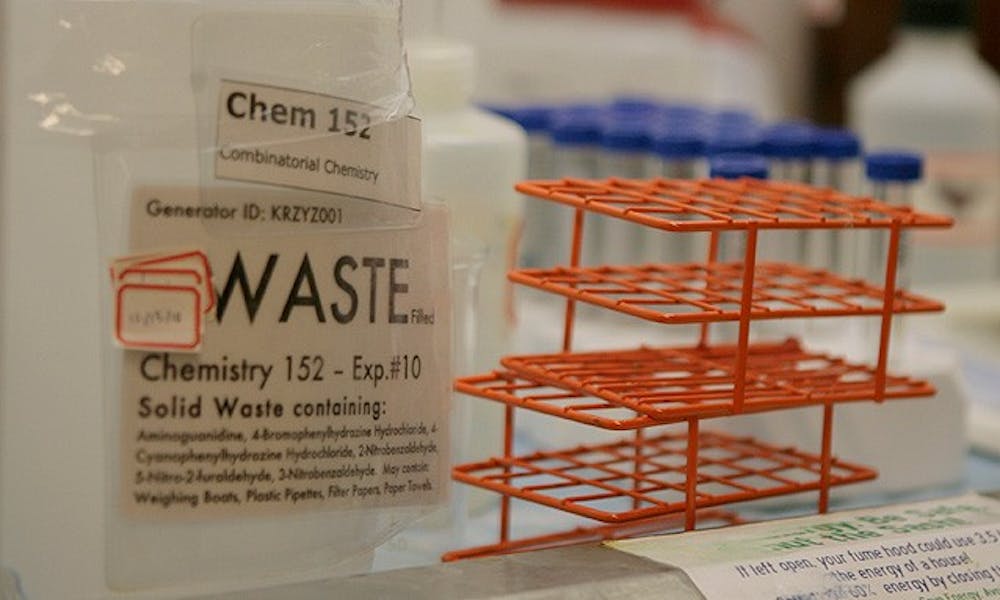Faculty and students rarely find themselves threatened by their own garbage.
But at Duke—with a multitude of science and medical laboratories—facilities generate high volumes of waste that can sometimes be hazardous.
The Occupational and Environmental Safety Office is in charge of monitoring and disposing of the University’s harmful waste. Wayne Thomann, director of the OESO, said the office has six divisions that cover major risk areas, including biological safety and occupational hygiene.
“There are not many functions that span all of Duke, but we’re one of those,” Thomann said, referring to the office’s broad scope.
OESO’s website provides detailed resources for students, employees and faculty regarding how to deal with hazardous substances. The website outlines specific protocols, including how labs can be set up safely and how items like a wedding ring can be retrieved after being inadvertently placed in a disposal container for sharp items such as needles and syringes.
Thomann said OESO takes a holistic approach to occupational safety, from laying out clear guidelines before purchasing dangerous substances to disposing of them.
“There’s a linkage from the initial purchase of that hazardous material through the risk associated with working with it and ultimately to the disposal,” he said.
Gary Tencer, assistant director of OESO, stressed the importance of improving awareness.
“People who recognize risks can better compensate for those risks,” he said.
Manager of Environmental Programs Bill Brewer oversees the disposal of hazardous materials. When scientists have chemicals they no longer need, they contact EP. The division then determines whether or not the substance is hazardous, checking it against a database of some 30,000 chemicals.
If the substance can be used elsewhere on campus, EP posts it on a surplus site. If they are not reusable, EP staff disposes of them.
Environmental Programs is also responsible for disposing of low-level radioactive waste.
“We allow [it] to decay and monitor [it] for 10 half lives,” Brewer said. “It takes almost half of our radioactive waste out of the disposal stream.”
Thomann added that it is cheaper to allow the radioactive material to decay at Duke than to immediately dispose of it.
Animal corpses generated by experiments and dissections go to the Vivarium, which eliminates them in a small animal incinerator or through the chemical process of hydrolysis rendering.
Especially potent biological toxins called select substances fall under the domain of Director of Biological Safety Debra Hunt. Some labs work with substances such as Yersinia pestis, the bacteria that caused the Bubonic Plague. Material like this must be registered with the Centers for Disease Control and Prevention.
“They are doing everything they need to do and we are very comfortable with them,” Hunt said.
Although research and medical labs use many hazardous materials, undergraduate teaching labs have intentionally been moving away from them in recent years. Terry Corliss, senior laboratory administrator and a manager of the undergraduate biology teaching labs, said that the labs prefer to substitute non-hazardous substances whenever possible.
“We’re really trying to give the same kind of hands-on experience to the students without using anything toxic,” Corliss said. “That’s our goal.”
Corliss recalled an incident in 2004 when an explosive substance slipped through the safety net. When clearing out an old stock of chemicals, Corliss and other faculty members discovered a jar of picric acid, a substance she said is “more explosive than dynamite” when it is dry.
“Very likely it was left over by someone who retired and it got pushed to the back and forgotten,” Corliss said.
OESO arrived at the site and evacuated the Biological Sciences Building. Corliss added that the room was filled with other potentially dangerous chemicals.
She recalled thinking at the time, “If the jar goes, the room goes. If the room goes, the building goes.”
OESO contacted a private subcontractor with experience in dealing with explosives, and the subcontractor then safely removed the picric acid.
“There is always going to be that potential for failure somewhere,” Thomann explained. “A lot of what we do is risk management, risk minimization.”
Tencer added that vigilance on campus is vital to upholding safety procedures.
“Things get fixed because people are aware of a hazard,” Tencer said “We would rather someone wave a flag [and] say, ‘Hey, this is an issue.’ That puts the process in place for corrective action.”
Get The Chronicle straight to your inbox
Signup for our weekly newsletter. Cancel at any time.

